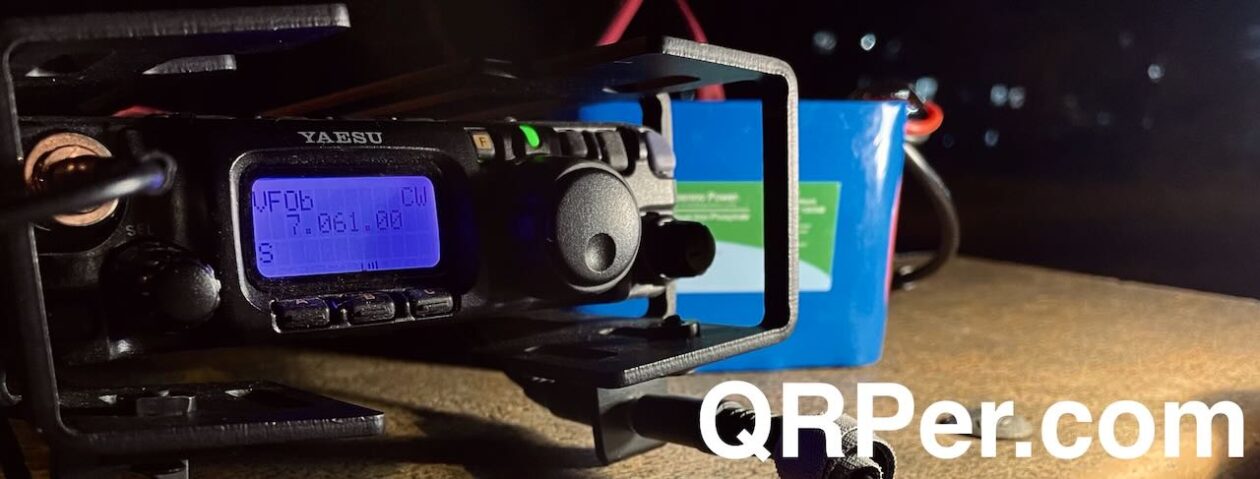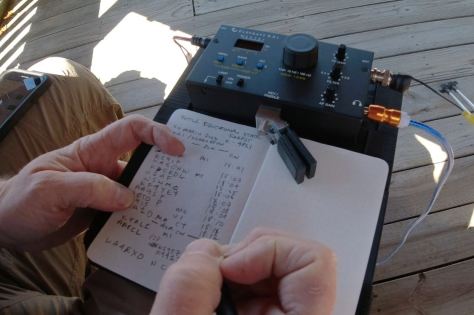 One of the things I love about our state and national parks is that no matter how often I visit, there’s almost always something new to discover.
One of the things I love about our state and national parks is that no matter how often I visit, there’s almost always something new to discover.
This is especially the case as the seasons change from winter to spring.
On March 20, 2022, I carved out enough time in my afternoon to fit in a quick activation of Tuttle Educational State Forest. My main goal, in truth, was fitting in a nice hike–the weather was beautiful, although it was rather gusty.
I needed a little “radio therapy” that day as I had been spending time in the hospital with my mom who had a nasty case of pneumonia. This was a few weeks ago and she’s feeling much better now, thankfully, but those hospital weeks in March were pretty stressful for all of us.
Field activations are such an effective way for me to get in a little exercise, a little radio time, and clear my mind; again, proper “radio therapy.”
Tuttle Educational State Forest (K-4861)
 For this trip, I packed the Elecraft KX1 field kit which included my K6ARK EFHW antenna since that was the last pairing I’d used int he field (click here to read that report). I did, however, transfer the KX1 to my new Pelican 1060 waterproof case.
For this trip, I packed the Elecraft KX1 field kit which included my K6ARK EFHW antenna since that was the last pairing I’d used int he field (click here to read that report). I did, however, transfer the KX1 to my new Pelican 1060 waterproof case.
 I actually have a solid yellow Pelican 1060 case for the KX1, but after reading about Leo’s QCX-mini field kit built in a clear-topped Peli 1060, I realized how much I missed having a clear lid on the 1060. I checked Amazon and discovered that their blue one was on sale, so I grabbed one. This was a total impulse purchase, by the way.
I actually have a solid yellow Pelican 1060 case for the KX1, but after reading about Leo’s QCX-mini field kit built in a clear-topped Peli 1060, I realized how much I missed having a clear lid on the 1060. I checked Amazon and discovered that their blue one was on sale, so I grabbed one. This was a total impulse purchase, by the way.
And for the record: I’m accused of being a radio enabler on a daily basis, but in my defence I promise the enabling works both ways! I’ve bought so many things based on reader recommendations. 
I wasn’t sure where I’d setup to play radio at Tuttle–there are so many options–but I knew I’d find a new-to-me spot somewhere in the forest along one of their many trails.

I started the hike and quickly noticed that the park recently re-blazed all of their trails–very nice.
 With new blazing, I was able to find spur trails I’d previously overlooked. One, in fact, was the “Gazebo Trail.”
With new blazing, I was able to find spur trails I’d previously overlooked. One, in fact, was the “Gazebo Trail.”
 I had heard about this trail but never actively sought it out. Last year, one of the park rangers told me it might be a nice spot to set up my station, but admitted that it was in a big clearing and the trees surrounding it weren’t terribly tall.
I had heard about this trail but never actively sought it out. Last year, one of the park rangers told me it might be a nice spot to set up my station, but admitted that it was in a big clearing and the trees surrounding it weren’t terribly tall.
All I can say is, I’m very glad I took the Gazebo Trail!
As I exited the trail, I could see the clearing and gazebo ahead and to my right, a very nice swing.
I instantly noticed at least four or five excellent spots to set up my gear, but the gazebo was calling me!
I walked up to the gazebo: what a fantastic space to play radio. I knew I’d be returning here frequently in the summer months when the cover/shade would be appreciated.
Better yet? The gazebo sits on a hill with amazing views of Grandfather Mountain (a SOTA summit I’ll be hitting later this year!).
 Although the trees on the back side of the Gazebo were relatively short, they were absolutely fine for hanging a lightweight 40 meter EFHW.
Although the trees on the back side of the Gazebo were relatively short, they were absolutely fine for hanging a lightweight 40 meter EFHW.
I actually include the full antenna deployment in my activation video (see below) including a total of three attempts to launch the throw line over the “perfect” branch. Those of you who think I’m some sort of master at launching throw lines will soon see that tales of my line skills have been grossly over exaggerated!
Gear:
- Elecraft KX1
- Pelican 1060 Weatherproof Case (affiliate link)
- Koh-I-Noor .9 mm Mechanical Pencil (affiliate link)
- Moleskine Cahier Journal (affiliate link)
- K6ARK Antenna Kit (affiliate link)
- N0SA SOTA Paddle (note: no longer in production)
- Spec-Ops Brand T.H.E. Pack EDC
- Bioenno 3 aH LiFePo Battery (Model BLF-1203AB)
- Mini Arborist throw line kit: Tom Bihn Small Travel Tray, Marlow KF1050 Excel 2mm Throwline, and Weaver 8 or 10oz weight
- Tom Bihn Large Travel Tray
- Rite In The Rain Weatherproof Cover/Pouch (affiliate link)
- N0RNM 3D printed knee board
- Camera: OSMO Action Camera (affiliate link)
After deploying the antenna, I very quickly set up the KX1 in the Gazebo.
On The Air
 I started calling CQ on 20 meters and was able to log the ten contacts needed for a valid park activation in only 10 minutes.
I started calling CQ on 20 meters and was able to log the ten contacts needed for a valid park activation in only 10 minutes.
Thank you POTA hunters!
I continued calling CQ for a while on 20 meters, then eventually moved to 40 meters.
Time was very limited this Sunday so I called QRT after 20 minutes on the air. I logged a total of 14 contacts: eleven stations on 20 meters and three on 40 meters.
Many thanks to W8APS and AA8CL for the Park-To-Parks!
QSO Map
Here’s what 2.5-3 watts into the counterpoise-less K6ARK EFHW can accomplish in 20 minutes on the air:

Activation video
Here’s my real-time, real-life, no-ad activation video. Once again, I put chapters into this YouTube video to make it easier to skip to the sections you might prefer. Note that there was a decent amount of wind noise during this particular activation:
Click here to view on YouTube.
Thank you!
 Thanks for coming along with me on this fun field activation.
Thanks for coming along with me on this fun field activation.
It was so nice to enjoy the great outdoors especially on a day my own internal batteries needed to be “recharged.” Going on a nice walk in the woods–and especially combining that with a little field radio fun–is the best medicine money can buy!
As always, I’d like to send a special thanks to those of you who have been supporting the site and channel through Patreon and the Coffee Fund. While certainly not a requirement as my content will always be free, I really appreciate the support. It makes videos and reports like this one possible.
Here’s wishing you a brilliant weekend ahead. I hope you get an opportunity to enjoy the great outdoors and/or play a little radio!
Cheers & 72,
Thomas (K4SWL)








Thank you Thomas for taking us along with you again. I’ve been thinking about the pelican cases and will rethink them.
Enjoyed the video.
73
Wb8yxf
Pelicans are great when you really want to protect something in your pack from the weight of other things packed around it and also excellent protection from moisture. I find that the price for smaller ones is also excellent. Made in the US to boot!
Cheers,
Thomas
Nice report, Thomas – and a reminder to me to order a smaller battery for my own activations. A 3AH is now on its way.
73,
John AE5X
I’ve found that 3AH is nearly ideal for me–it’ll get me through multiple activations paired with most of my QRP radios.
Thomas
Enjoyed very much Thomas. Glad your mom is doing better.
Thank you, Robert!
I ended up getting a Pelican 1040 w/foam, for my Mtn Tpr 4. I have 2 Tom Bihn HLT’s (yes 2, it’s your fault) inbound, to put together the same kit you’re running for your Mtn Tpr.
I also got the Bioenno 9v in and it holds above 4w out for a long time as the battery drains. I’m amazed.
Got a Co. trip in July to Key West and gonna try a pota activation at a park there, with the Mtn Tpr.
Ha ha! You’re addicted to Tom Bihn now, too! Sorry about that, OM.
Sorry about that, OM.
Sounds like you’ve got a great field kit for Colorado. You’ll have to let us know how well it all works out for you.
Interesting activation.
As a newcomer to this sie ( and newPateon supporter), how do you generate the QSO maps?
73 de ei2jp
Thank you so much, Ron!
I use QSO Map: https://qsomap.org/
It’s great and pretty easy to use with numerous map options. Simply upload your ADIF (.adi) file and after it processes the log, it’ll allow you to create a map.
Thanks for the support, Ron!
Cheers,
Thomas
Ron
http://www.qsomap.org is the mapping app I use, pretty sure thats what is used above.
-marc
K8MH
I gave up on QRP about 3 years ago during the solar minimum, but reading your blog has re-awakened my interest. So I dug out my old Hendricks PFR3, hooked it up to a random wire and made a POTA QSO this week. My whole QRP portable field station fits into a small shoulder bag that is so light it almost defies gravity (trust me I have a Bachelors degree in Physics!). Thanks for the inspiration Thomas.
That is wonderful! Wow–a PFR3. I haven’t seen one of those in ages. By the time I got around to buying one they were no longer available–always thought it was a cute radio. Thank you for the kind comments, John.